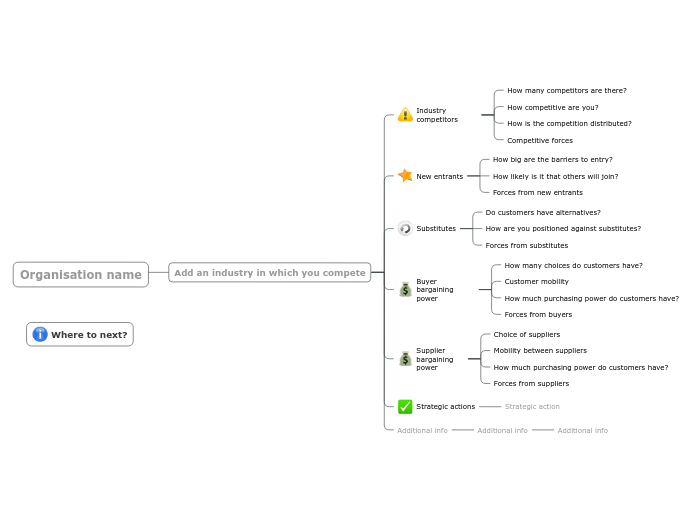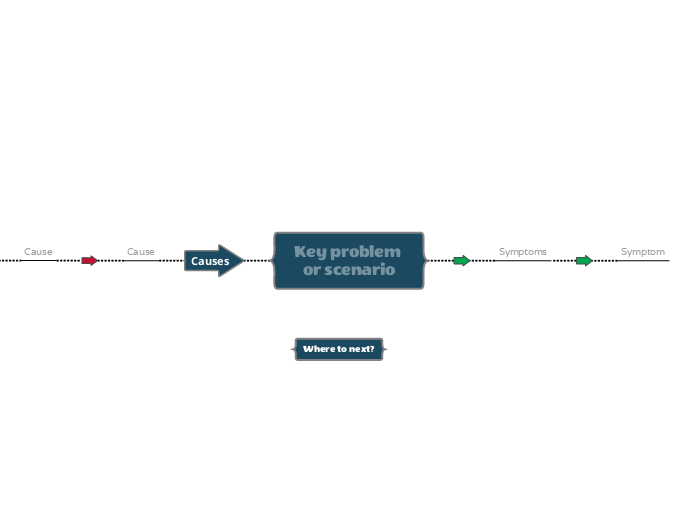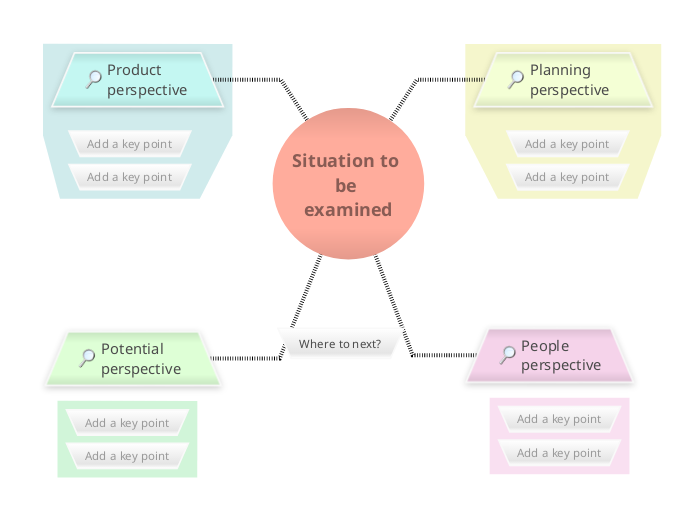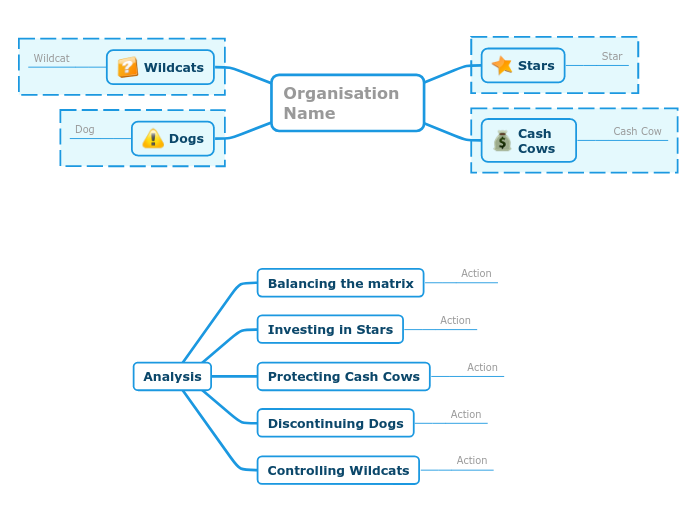Where to next?
Although this analysis is fairly simplistic, it may take some time to develop, because it needs good insight into the behavior of each industry or market in which you compete.
It is worth collaborating with your colleagues, who may each have specialist knowledge in one or two sectors. Inputs can then be combined to prioritize strategic actions.
Share your mind map
Organisation name
Begin by typing in the name of your organisation.
Add an industry in which you compete
Type in the name of an industry or sector in which your organisation competes.
This mind map will help you to analyse your position in that industry.
Additional info
Strategic actions
Strategic action
Looking at the positive and negative forces in each market, type in a strategic action based on the importance and volume of the market, and the strength of negative forces.
Strategies may include:
- Making your products and services more competitive in this market
- Making your products and services more difficult to emulate, deterring others from joining the market
- Making your products and services more valuable when compared to substitutes
Supplier bargaining power
Forces from suppliers
Looking at the answers above, how do you rate the bargaining power of suppliers of materials and services used in this market?
There are only a few suppliers and we are locked inWe have limited freedom for negotiation with our suppliersWe can control price negotiations with our suppliers
Do you make big enough purchases to be able to negotiate pricing with your suppliers in this market?
Rate your purchasing power:
Our purchase volumes are not really important to our suppliersWe get the same discounts as everyone elseOur purchases are big enough to make suppliers deal with us personally
Mobility between suppliers
Is it easy for you to switch between suppliers for the materials and services you purchase?
Rate your mobility by choosing an option below:
We are locked into single suppliers and it would be expensive to change themWe could switch if we needed toIt is easy for us to use materials and services from multiple suppliers
Choice of suppliers
How many choices do you have in terms of suppliers? Are there many suppliers for the materials you use?
Assess your range of choice by choosing an option below:
We have trouble finding alternative sources of supply for the materials and services we needThere are a few suppliers for the materials and services we buyWe can purchase similar materials and services from multiple suppliers
Buyer bargaining power
Forces from buyers
Looking at the answers above, how do you rate the bargaining power of buyers in this market?
Customers can control price negotiations by having the freedom to take important business elsewherePrice negotiations do happen but are balancedCustomers cannot negotiate terms
How much purchasing power do customers have?
Do customers make enough purchases to negotiate their pricing?
Rate their purchasing power by choosing an option below:
Customers make significant purchases and demand discountsSome discounts are expected, but we can control themPricing is not usually negotiable and customers accept our pricing
Customer mobility
Is it easy for customers to switch between comparable products and services?
It is easy and inexpensive for a customer to switch from one vendor to anotherCustomers can switch if they are motivated toCustomers are generally locked into a product or service, and it is costly to switch
How many choices do customers have?
Are there multiple sources of comparable products and services?
Assess the customer's freedom of choice by choosing an option below:
There are many vendors with very similar products or servicesThere are only a few vendors of comparable products and servicesMost of the products and services have special features
Substitutes
Forces from substitutes
Looking at the answers above, how do you rate your position against substitutes?
Customers can easily adopt substitutes and our product or service is not compellingSubstitutes are available, but customers usually prefer our type of product or serviceThere are few viable substitutes and our type of product or service is valued by customers
How are you positioned against substitutes?
Is your product or service attractive, when compared to the substitutes available to customers?
Rate your position:
Our product or service requires more customer commitment and appreciation than many of the substitutesOur product or service is roughly equal to most of the substitutesOur product or service is a more compelling option than most of the substitutes
Do customers have alternatives?
How essential is your product or service to customers? Are there many alternatives to buying from you?
Assess the range of alternatives:
Our product or service is optional, and/or it is easy for customers to find substitutesCustomers prefer to buy, but can find substitutes if motivatedOur product or service is essential, and/or there are very few acceptable substitutes
New entrants
Forces from new entrants
Looking at the answers above, how do you rate the position of new entrants in the market?
It is both easy and attractive for new entrants to join this marketNew entrants could join if they perceive enough advantagesIt is both difficult and unattractive for new entrants to join
How likely is it that others will join?
Rate the probability by clicking an icon below:
Probable: it is a profitable market and demand keeps prices highPossible: it is a growing market and could be profitable in the futureUnlikely: profits are low, and the market is already saturated, or even shrinking
How big are the barriers to entry?
If a new organization wanted to join this industry, how big are the barriers to entry?
Assess the barriers by choosing an option below:
Few barriers, making it easy for others to walk inAnother organization could join with some dedicationSerious investment is needed to join this industry
Industry competitors
Competitive forces
Looking at the answers above, how do you rate your competitive position in the market?
Our competitive position is a negative force that makes us vulnerableOur competitive position is neither helping nor hinderingOur competitive position is a positive force for us
How is the competition distributed?
Are there lots of similar players, or is the market dominated by a few players?
Rate the distribution:
A few major names dominate the market, but we are a minor playerThe market is not really dominated by anyoneA few major names dominate the market, and we are one of them
How competitive are you?
Rate your competitiveness by choosing an option below:
We often lose to competitorsWe win sometimes and lose sometimesWe win most of the time
How many competitors are there?
Assess the amount of competition by choosing one of the options below:
Lots of competitors, making it hard to get noticedA few competitorsAlmost no competitors and little choice








